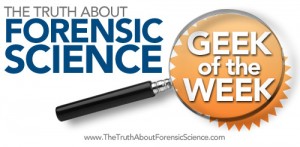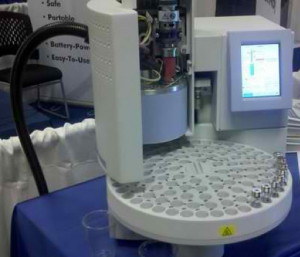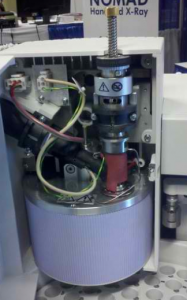Our good friend, Ron Moore, Esquire writes us “I actually had a client researching lawyers who looked at the Truth About Forensic Science geek of the week posts and liked my answers. It made a difference in who he decided to hire. Thanks!” So, there is a lot of value in www.TheTruthAboutForensicScience.com Forensic Science Geek of the Week Challenge. Try it out today.
Forensic Science Geek of the Week
Thanks to the combined inspiration of Christine Funk, Esquire and Chuck Ramsay, Esquire, a new twist of this blog is being introduced. A weekly fun forensic science challenge/trivia question. The winner will be affectionately dubbed “www.TheTruthAboutForensicScience.com Forensic Science Geek of the Week.”
Rules:
- The challenge will be posted Sunday morning 12 noon EST.
- Answers to the challenge will be entered by responding to this blog post or the www.TheTruthAboutForensicScience.com FaceBook fan page.
- All comments that are answers to this blog will released after 9pm EST.
- The first complete and correct answer will be awarded the envious title of “www.TheTruthAboutForensicScience.com Forensic Science Geek of the Week”
- “www.TheTruthAboutForensicScience.com Forensic Science Geek of the Week” is entitled a one time post of his/her picture on this blog and the www.TheTruthAboutForensicScience.com FaceBook fan page. The coveted title will be his/her for that week. Additionally, a winner will be allowed one link to one webpage of his/her choice. Both the picture and the weblink is subject to the approval of Justin J McShane, Esquire and will only be screened for appropriate taste.
- The winner will be announced Sunday night.
- A winner may only repeat two times in a row, then will have to sit out a week to be eligible again. This person, who was the two time in a row winner, may answer the question, but will be disqualified from the honor so as to allow others to participate.
- This is for learning and for fun. EVERYONE IS ENCOURAGED TO TRY TO ANSWER THE WEEKLY QUESTION. So give it a shot.
Here it is:
The www.TheTruthAboutForensicScience.com “Forensic Science Geek of the Week” challenge question. Remember the first full and complete answer wins the honor and also gets his/her photo displayed, bragging rights for the week and finally website promotion.
OFFICIAL QUESTION:
1. What is the top picture show?
2. What does the second picture show?
3. What type of analysis is this device used for?
The Hall of Fame for the www.TheTruthAboutForensicScience.com Forensic Science Geek of the Week:
Week 1: Chuck Ramsay, Esquire
Week 2: Rick McIndoe, PhD
Week 3: Christine Funk, Esquire
Week 4: Stephen Daniels
Week 5: Stephen Daniels
Week 6: Richard Middlebrook, Esquire
Week 7: Christine Funk, Esquire
Week 8: Ron Moore, B.S., J.D.
Week 9: Ron Moore, B.S., J.D.
Week 10: Kelly Case, Esquire and Michael Dye, Esquire
Week 11: Brian Manchester, Esquire
Week 12: Ron Moore, B.S., J.D.
Week 13: Ron Moore, B.S., J.D.
Week 14: Josh Lee, Esquire
Week 15: Joshua Dale, Esquire and Steven W. Hernandez, Esquire
Week 16: Christine Funk, Esquire
Week 17: Joshua Dale, Esquire
Week 18: Glen Neeley, Esquire
Week 19: Amanda Bynum, Esquire
Week 20: Josh Lee, Esquire
Week 21: Glen Neeley, Esquire
Week 22: Stephen Daniels
Week 23: Ron Moore, B.S., J.D.
WEEK 24: Bobby Spinks
WEEK 25: Jon Woolsey, Esquire
WEEK 26: Mehul B. Anjaria
Week 27: Richard Middlebrook, Esquire
WEEK 28: UNCLAIMED, IT COULD BE YOU!!!!
WEEK 29: Ron Moore, Esquire
WEEK 30: C. Jeffrey Sifers, Esquire
WEEK 31: Ron Moore, Esquire
WEEK 32: Mehul B. Anjaria
WEEK 33: Andy Johnston
WEEK 34: Ralph R. Ristenbatt, III
WEEK 35: IT COULD BE YOU






Brian Manchester says:
1. This device is called an auto-sampler. The carousel holds multiple vials full of samles. The carousel then rotates and individual vials are tested.
2. The second picture depicts the part of the auto-sampler where a sample is taken from the individual vials. The cylindrical part with the red bottom on the right hand side of the picture holds the device that picks up the headspace vials and this is where the needle that removes the headspace sample is also located.
3. This device is used in headspace gas chromotography (HS-GC). In headspace gas chromotography samples are prepared and put in sample vials. The sample vials are either crimped or have screw on caps. The vials are then placed in the carousel and heated until equilibrium is reached between the liquid part of the sample and the air above the liquid. The scientific principal behind this is based on Henry’s Law. Henry’e law states: at a constant temperature, the amount of a given gas dissolved in a given type and volume of liquid is directly proportional to the partial pressure of that gas in equilibrium with that liquid. The air above the sample is called the headspace.
Once equilibrium is reached the carousel is then rotated to the part of the auto-sampler depicted in picture number two. It is here that a needle is inserted through the septum located on the cap of the headspace vial. A sample of the headspace gas is then taken where it is transfered into the injection port of a gas chromoatograph for testing.
HS-GC is the method most often used for forensic testing for ETOH in blood samples.
Brian Manchester
Kelly W. Case says:
The first pic is of the Perkin Elmer autosampler for a Gas Chromatograph. The sample tray heats and moves in a configuration allowing the samples to be tested in one complete batch. The second photo is the needle and mechanics driving the piercing mechanism in the sample to obtain a sample of the headspace gas, in blood testing, and then distribues the sample into the injector port of the GC machine, where testing begins.
Kelly W. Case says:
Forgot to mention that this one of the uses of this testing is for testing blood for ethanol content. However, it’s use is not limited that that type of testing only. It is used to separate molecular compound into their individual components, allowing us to determine how much time it takes for an analyte to travel a specific distance with parameters of heat column length and flow rate all constant. Once the printout is obtained showing the amount of time that a given substance took to elute, that can be compared to known separation times for other substances to determine what the test substance was composed of.
Ron moore says:
The first picture is a carousel for an autosampler. It looks a lot like the HS110 I used to use. The second picture is of the internal heater carousel that incubates 12 headspace vials prior to injection, and the crane that loads and unloads vials. We used to have crane errors when something got out of alignment. They are the sampling system for headspace gc, as done for alcohol analysis.
Josh Lee says:
1) The top picture is that of a Headspace Autosampler, carousel, and headspace vials.
2) The second picture shows the inside workings of the Autosampler. Inside there is an automated needle that will penetrate down into the headspace vials and draw in a sample and inject it into the device it is attached to; likely a Gas Chromatograph.
3) It is used for headspace testing of blood samples for drugs and alcohol of citizens accused of driving under the influence.
Robert Lantz, Ph.D. says:
The top picture is of the autosampler tray for a GC (I am drawing a blank on the brand). The second shows, among other components, the stepper motor of the robotic injector tower. GC is used for a heap of analyses. The A/S vials are too small for use with headspace analysis, but would be used for liquid injection. This could be anything from ethanol in blood to much larger molecules, so long as they will evaporate.
Justin J. McShane says:
What a great answer! You win.
Justin J. McShane says:
This too is a great answer. Just a little bit quicker and you would have made it!
Justin J. McShane says:
You are also right (you even got the model correct), but you are slipping in that you are a little late this week or you would have won!
Justin J. McShane says:
Awesome! But too slow. Next time surely you will win.
Justin J. McShane says:
2 weeks in a row honorable mention. Awesome. Thanks Doc.